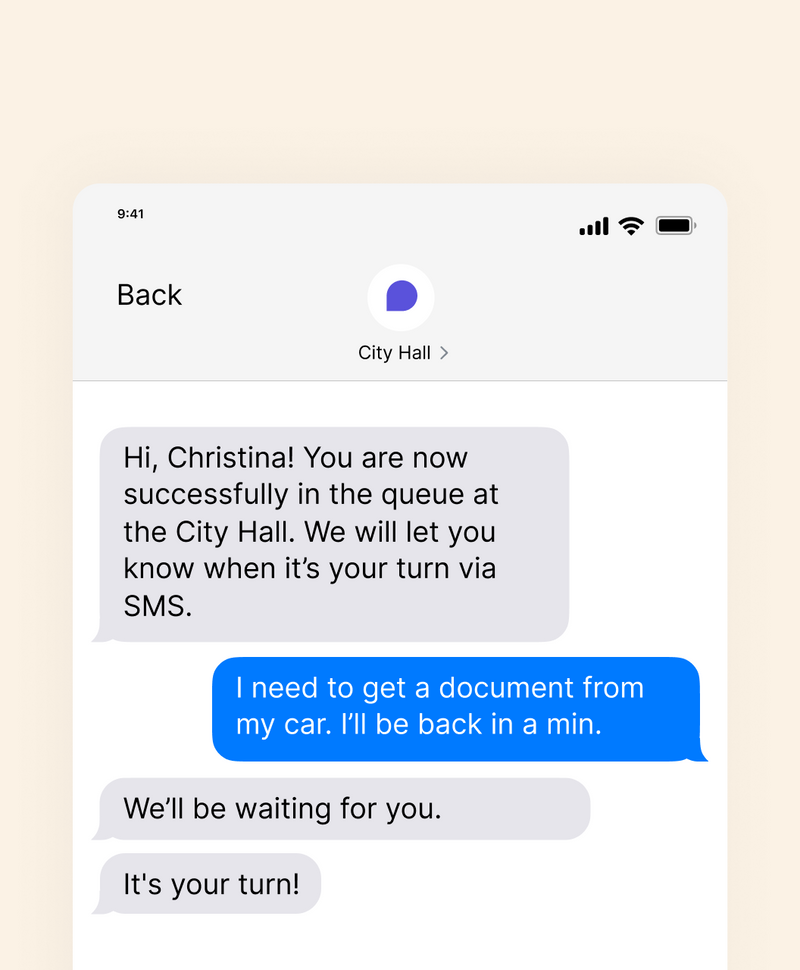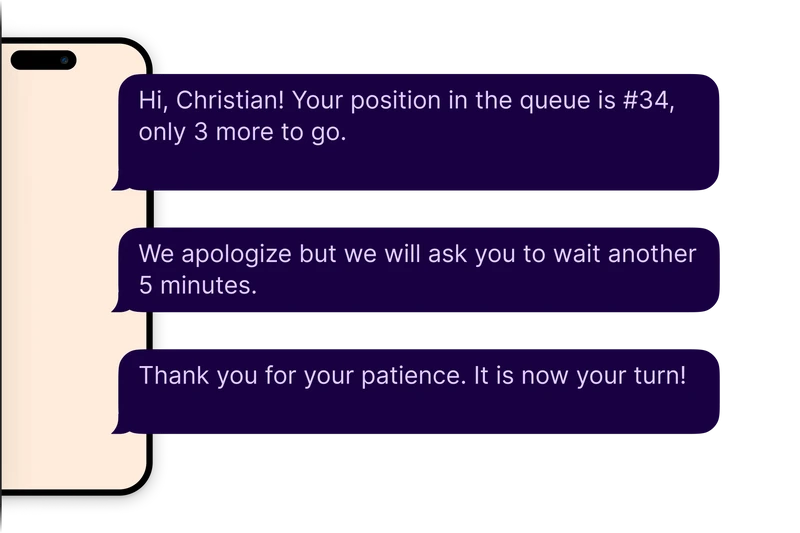People in queues bring wildly different attitudes to the waiting game. Some stay zen-like while others tap their feet and check their watch every ten seconds.
Each person handles waiting their own way. Understanding the types of people in a queue gives businesses the edge in creating better experiences, you manage expectations smarter and keep service flowing.
From patient rule-followers to sneaky line-cutters, knowing these different types means staff can tackle problems before they explode.
Here are the 7 types of people you'll encounter in every queue and how each one changes your customer service game.
Types of People You’ll Encounter in a Queue
Queues aren’t one-size-fits-all. Understanding the different types of people you’ll encounter in a queue helps manage lines more efficiently and improve customer experience. Let’s take a look:
1. The Early Bird
The Early Bird always shows up first, arriving way before the scheduled time to grab that prime spot. They're determined to dodge any potential delays. Their punctuality might seem admirable, but they often create their own problem, waiting way longer than anyone else.
Qualities of The Early Bird:
Plans everything ahead to dodge last-minute stress
Grabs the best spot in line, showing up before everyone else
Waits longer than needed since they arrive ridiculously early
Loves feeling in control and prepared for anything
Gets overly eager, basically creating unnecessary wait times for themselves
With virtual queuing and online appointment scheduling, businesses can let the Early Bird reserve their spot in advance, eliminating unnecessary wait times and ensuring a smoother experience for all.

2. The Impatient One
The Impatient One checks the time constantly, taps their foot, and complains about the wait. This person broadcasts frustration, delays just make it worse. They demand immediate answers and speak up loudly about their dissatisfaction. Staff needs to address their concerns fast before tension explodes.
Psychologist Daniel Kahneman proposed that queuing has a dual effect on us — we become gradually demoralized as we wait, but also react positively to each forward movement. For The Impatient One, this means every small sign of progress matters. Visible updates or even brief notifications can help ease their anxiety and restore a sense of control.
Qualities of The Impatient One:
Checks the time obsessively, anxious about delays
Asks the same questions repeatedly, hunting for reassurance or quick fixes
Gets frustrated easily by delays, agitation shows immediately
Fidgets visibly or paces back and forth while waiting
Escalates tension when concerns don't get addressed quickly
Spot The Impatient One early and you can offer timely SMS updates and jump on problems before frustrations boil over.

Also read - How to Improve Customer Communication With SMS Text Messaging
3. The Socializer
The Socializer turns every queue into a social event. They use waiting time to chat with others around them, small talk, casual conversation, whatever works. These people pass time by connecting with fellow customers. Their chatter helps ease tension in the line, though they sometimes distract others who just want to wait quietly.
Qualities of The Socializer:
Lightens the mood in line with friendly conversation
Chats with others to make waiting feel faster
Takes people's minds off how long they're waiting
Creates a community feeling, relaxing the whole atmosphere
Can slow things down when conversations run too long or distract others
Adding real-time queue updates and waiting room screens helps businesses keep The Socializer from disrupting flow. Everyone stays informed and engaged without losing track of the queue.

4. The Silent Observer
The Silent Observer stays quiet and keeps to themselves while waiting in queues. They skip the conversation, preferring to watch their surroundings and wait alone. Don't mistake their silence for disengagement, they're highly aware of everything happening around them, catching small details others miss completely.
Qualities of The Silent Observer:
Watches surroundings and catches details others overlook
Spots inefficient processes, delays, or areas needing improvement
Keeps to themselves throughout the entire wait
Has sharp eyes for small inefficiencies that slip past everyone else
Want to serve The Silent Observer well? Focus on clear signage and smooth processes. These customers value efficiency and clarity above everything else.
5. The Multi-Tasker
The Multi-Tasker treats waiting time as productivity time. They catch up on work, scroll through phones, or hammer out emails while standing in the queue. They use every minute efficiently. Unlike others, the wait length doesn't bother them, they're too busy getting stuff done.
Qualities of The Multi-Tasker:
Beats boredom by staying busy with work or personal tasks
Seems unbothered by line length since they're focused elsewhere
Turns waiting into productive time - emails, social media, whatever needs doing
Gets satisfaction from accomplishing tasks during dead time
To win over The Multi-Tasker, offer free Wi-Fi, charging stations, or workspace areas while they wait. Make their time productive and they'll appreciate the thoughtfulness.
6. The Rule Follower
The Rule Follower sticks to every rule without exception. They never cut lines, always follow signage, and expect everyone else to do the same. Fairness and order drive everything they do in the queue. Well-organized processes make them happy, but rule-breakers drive them up the wall.
Qualities of The Rule Follower:
Maintains fairness by following every rule to the letter
Gets irritated by rule-breakers, especially line-cutters
Values order and structure above all else during waits
Feels anxious when processes seem disorganized or chaotic
Keep The Rule Follower happy with clear signage and virtual queuing systems. When everyone follows the same process, confusion disappears and fairness stays intact throughout the line.

7. The Distracted One
The Distracted One can't stay focused while waiting in queues. They browse their phone, chat away, or daydream through the whole experience. They lose track of when their turn comes up. Without reminders or clear guidance, they miss their spot in line and create frustration for everyone involved.
Qualities of The Distracted One:
Misses announcements or verbal cues about their turn
Needs constant reminders to track queue progress
Requires extra guidance to follow the right steps
Zones out easily, needing alerts to stay on track
SMS notifications or digital queue screens keep The Distracted One informed in real time. They won't miss their turn and the queue keeps flowing smoothly for everyone else.

Also read - 8 Queue Management System Features Your Business Needs
How Understanding Different Types of People in Queue Helps
Spotting different types of people in a queue arms businesses with insights to run lines better and create smoother experiences:
Anticipate behaviors: When staff recognizes the impatient person, the socializer, or the distracted one, they jump on problems before they blow up.
Reduce stress: Targeted messaging and signs for each personality type means less confusion and fewer frustrated customers all around.
Maintain fairness: Knowing how people standing in a queue think differently helps apply rules evenly. Early birds and rule-followers both get what they need.
Optimize operations: Teams shift their speed, move resources around, or provide assistance exactly where the pressure builds.
Use digital tools: Queue management systems handle all these different behaviors using virtual check-in, appointment booking, and custom alerts that match each person's style.
Make Every Queue a Positive Experience
Understanding the different types of people in a queue makes all the difference for smooth, efficient, satisfying waits. Spot behaviors, from The Early Bird to The Distracted One, and staff can predict what's needed, cut frustration, and keep everything fair.
Tailor your approach to each personality type. Watch flow improve, customers stay informed, and satisfaction jumps.
Qminder simplifies everything with virtual check-in, appointment scheduling, and automated notifications.
Start using Qminder today to optimize queues and make every customer in line happy.
Recognizing different types of people in a queue lets staff predict needs, cut frustration, and customize service. Satisfaction goes up and flow gets better.
Yes. Queue management systems like Qminder offer virtual check-ins, appointment scheduling, and notifications. They handle impatient, distracted, or social customers while keeping lines organized and moving.
Sticking only to rules frustrates certain customers. When staff observes behaviors and adapts, they maintain fairness while making sure everyone in the queue feels seen and supported.





